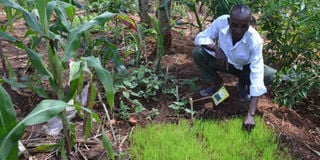Residents of arid Eastern Counties cultivate using innovative techniques that put food on tables

Venanzio Njiru inspects his rice nursery in Mbeere. He uses permaculture to produce enough food for his family of three and some for sale throughout the year. PHOTO | ISAIAH ESIPISU | NMG
What you need to know:
- Three quarters of the bottle is then buried near the seedling, with the hole directed to the taproot. The bottle is refilled once every week.
- Top-soil is then introduced in the basin before the arrowroots are planted. The basins are watered every fortnight.
- It is a practical method of developing ecologically harmonious, efficient and productive systems that can be used by anyone and anywhere.
- Mr Njiru keeps cattle, indigenous chickens and goats, whose droppings make manure. He also rears tilapia and catfish in his four ponds.
With little water, farmers in the dry parts of eastern Kenya have made themselves food secure by using home-grown techniques to grow arrow roots, bananas, pawpaws, vegetables and other crops.
The county governments of Embu, Tharaka-Nithi and Kitui in collaboration with faith-based organisations and the Pan African Climate Justice Alliance are using such knowledge to develop climate change policy documents to be tabled in their assemblies soon.
This comes when studies show that temperatures in 21 semi-arid counties have increased substantively in the last 50 years.
“We’ll need county customised policies that address climate change in relation to prevailing conditions, keeping in mind the projections, which show that temperatures may still increase,” Dr Mohammed Said, a researcher, said.
In Kangondi village of Makueni County, Mr Boniface Muema Ndangili has discovered a way of growing fruit trees with little water.
“For every new seedling, all I need is a one-litre plastic bottle of water,” he says.
After planting the seedling, he digs a small hole and the base of the stem and pokes the bottle at the bottom using a nail.
Three quarters of the bottle is then buried near the seedling, with the hole directed to the taproot. The bottle is refilled once every week.
The father of two has two acres of his land under mangoes. Some are already producing fruits.
Mr Ndangili grows other crops on the same piece of land, including arrowroots, bananas and vegetables.
To grow arrowroots for example, he digs a shallow basin like structure before spreading a thick polythene paper lining in it to prevent water from percolating into the porous ground.
ALL IN ONE NATURAL ECOSYSTEM
Top-soil is then introduced in the basin before the arrowroots are planted. The basins are watered every fortnight.
Using simple techniques such as zai-pits and mulching to keep soils moist, Mr Ndangili says 90 per cent of his crops survive, up from five per cent in the last one year.
In the dry parts of Embu and Tharaka-Nithi counties, farmers have embraced a technique called permaculture.
This can be described as an all-in-one natural ecosystem. The term ‘permaculture’ was coined by David Holmgren and his professor Bill Mollison in 1978.
It is a practical method of developing ecologically harmonious, efficient and productive systems that can be used by anyone and anywhere.
In Kyenire village, Mbeere North Sub-County, Mr Venanzio Njiru uses permaculture to produce enough food for his family of three and some for sale throughout the year.
His lush one-acre farm sharply contrasts with the surrounding environment that is characterised by brown grass and leafless trees.
Using water piped from River Thosi, some 10 kilometres away, the former hawker has a mosaic of cover crops, leguminous plants, fruit trees and others intercropped with maize planted in zai-pits. He also grows sugarcane.
Mr Njiru keeps cattle, indigenous chickens and goats, whose droppings make manure. He also rears tilapia and catfish in his four ponds.





